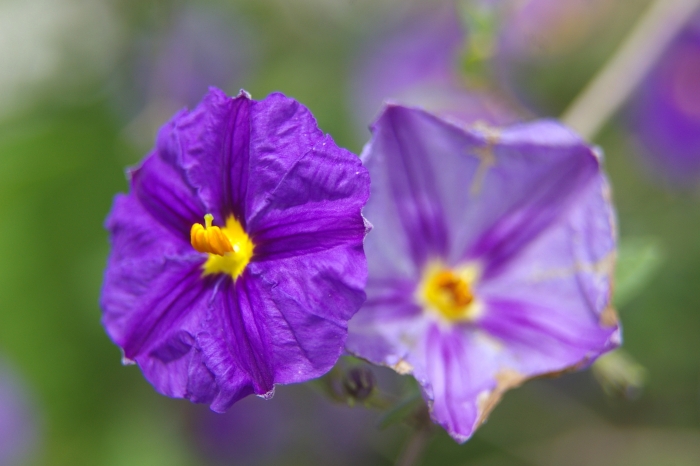Blue Potato Bush
(Lycianthes rantonnetii)
Blue Potato Bush (Lycianthes rantonnetii)
/
/

Matthew Sainsbury
CC BY-SA 3.0
Image By:
Matthew Sainsbury
Recorded By:
Copyright:
CC BY-SA 3.0
Copyright Notice:
Photo by: Matthew Sainsbury | License Type: CC BY-SA 3.0 | License URL: https://creativecommons.org/licenses/by-sa/3.0 | Uploader: EChastain | Publisher: Wikimedia Commons | Title: Blue_potato_bush_flowers.jpg | Notes: Transferred from en.wikipedia: see original upload log above |











































Estimated Native Range
Summary
Lycianthes rantonnetii, commonly known as Blue Potato Bush, is an evergreen shrub native to Brazil and Argentina, where it thrives in a variety of habitats including forest margins, shrublands, and along streams. It typically grows to about 6 feet (1.8 meters) tall and wide, with a rounded, somewhat lax habit. The Blue Potato Bush is adorned with a profusion of trumpet-shaped, bright blue-purple flowers with a prominent yellow center, blooming from summer into fall. The flowers are quite showy and attract pollinators. After flowering, it produces small, red berries. Despite its common name and its relation to food plants like the potato and tomato, all parts of the plant are toxic to humans.
This shrub is valued for its ornamental qualities, including its vibrant flowers and ease of maintenance. It is often used in residential landscapes, as a container plant, and in coastal gardens due to its tolerance of salt spray. The Blue Potato Bush prefers a sheltered location with full sun to part shade and requires well-drained soil. It is moderately drought-tolerant once established but benefits from regular watering during prolonged dry periods. In regions with cold winters, it can be grown in a container and brought indoors or into a greenhouse to overwinter. While generally pest-free, it can be susceptible to whiteflies and spider mites, especially when grown under glass.CC BY-SA 4.0
This shrub is valued for its ornamental qualities, including its vibrant flowers and ease of maintenance. It is often used in residential landscapes, as a container plant, and in coastal gardens due to its tolerance of salt spray. The Blue Potato Bush prefers a sheltered location with full sun to part shade and requires well-drained soil. It is moderately drought-tolerant once established but benefits from regular watering during prolonged dry periods. In regions with cold winters, it can be grown in a container and brought indoors or into a greenhouse to overwinter. While generally pest-free, it can be susceptible to whiteflies and spider mites, especially when grown under glass.CC BY-SA 4.0
Plant Description
- Plant Type: Shrub
- Height: 2-12 feet
- Width: 4.5-6 feet
- Growth Rate: Rapid
- Flower Color: Purple
- Flowering Season: Summer
- Leaf Retention: Evergreen
Growth Requirements
- Sun: Full Sun, Part Shade
- Water: Low, Medium
- Drainage: Medium
Common Uses
Bee Garden, Bird Garden, Border Plant, Butterfly Garden, Deer Resistant, Drought Tolerant, Fragrant, Hummingbird Garden, Low Maintenance, Showy Flowers, Street Planting
Natural Habitat
Native to forest margins, shrublands, and along streams in Brazil and Argentina
Other Names
Common Names: Paraguay Nightshade, Blue Potato-Bush, Himmelsöga, Blue Potato Bush
Scientific Names: , Solanum rantonnetii, Lycianthes rantonnetii, Lycianthes rantonnei, Solanum urbanum, Solanum muticum, Solanum corniculatum, Solanum japonicum, Solanum urbanum var. nervosum, Solanum urbanum var. typicum
GBIF Accepted Name: Lycianthes rantonnetii (Carrière ex Lesc.) Bitter